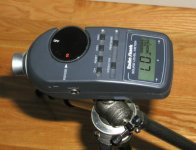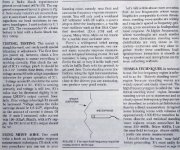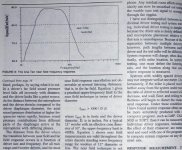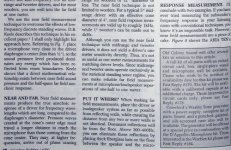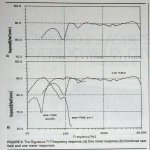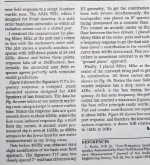What is the best way to test the performance of my Sub?
I have recently finished a subwoofer for a friend’s home theater. I have had my subs professionally tested in the past but my friend doesn’t want to spend the money on this analysis, so I was wondering what is the best way to do this in my home with simple tools? IE: computer tone generator and a DB meter… is it even possible to get accurate results with these types of tools. If it is possible to get accurate results in this simple manner, how do I do it? Could some of you guys help me out? Step by step instructions would be nice.
Thanks a lot,
Slice 😎
Note: I am probably going to get the funding in a few months to build a sub of rather large size and weight. I am using a self-designed enclosure witch if all goes well will provide amazing results, and I will be doing in step by step on DIYAudio!
I have recently finished a subwoofer for a friend’s home theater. I have had my subs professionally tested in the past but my friend doesn’t want to spend the money on this analysis, so I was wondering what is the best way to do this in my home with simple tools? IE: computer tone generator and a DB meter… is it even possible to get accurate results with these types of tools. If it is possible to get accurate results in this simple manner, how do I do it? Could some of you guys help me out? Step by step instructions would be nice.
Thanks a lot,
Slice 😎
Note: I am probably going to get the funding in a few months to build a sub of rather large size and weight. I am using a self-designed enclosure witch if all goes well will provide amazing results, and I will be doing in step by step on DIYAudio!

you can get a test CD with a warble tone. I know Sterophile made one. I got one from a bin in NYC.
also you can try the 1812 by Tchaikovsky. Get a good recording. MF or Sterophile.
just start with low volume on your amp.
some of these lows can rattle the spiders on lesser woofers. then you have a busted woofer.
regards
navin
also you can try the 1812 by Tchaikovsky. Get a good recording. MF or Sterophile.
just start with low volume on your amp.
some of these lows can rattle the spiders on lesser woofers. then you have a busted woofer.
regards
navin
Pass DIY Addict
Joined 2000
Paid Member
Slice,
Get yourself a copy of the Stryke Basszone Test CD , it sells for about $10. It has test tones from 10Hz to 20,000 kHz on it and is especially good for testing subs. Next, get yourself a Radio Shack analog SPL meter (cheaper and many claim its easier to read).
Run the test tones and record the SPL levels (set meter to "Average" or "Slow" reading and "C" weighted). Then, add the following correction values to the meter readings (compensate for its limitations):
***Radio Shack SPL Meter Correction Values***
To find the corrected values just add the figures below to your measured results.
10Hz add 20
12.5Hz add 16.5
16Hz add 11.5
20Hz add 7.5
25Hz add 5
31.5Hz add 3
40Hz add 2.5
50Hz add 1.5
63Hz add 1.5
80Hz add 1.5
100Hz add 2
125Hz add .5
160Hz add -.5
200Hz add -.5
250Hz add +.5
315Hz add -.5
400Hz add 0
500Hz add -.5
630Hz add 0
800Hz add 0
1kHz add 0
1.25kHz add 0
1.6kHz add -.5
2kHz add -1.5
2.5kHz add -1.5
3.15kHz add -1.5
4kHz add -2
5kHz add -2
6.3kHz add -2
8kHz add -2
10kHz add -1
12.5kHz add +.5
16kHz add 0
20kHz add +1
What you want to see is relatively flat response between 20Hz and 100Hz after applying the correction values listed above. If you have lots of peaks and valleys in your response curve, try different placement of your sub. If moving it around does not even out the response, you can use and EQ to remove peaks, but valleys (null points) are absolutely unaffected by equalization as they are caused by interference patterns of sound reflection.
Get yourself a copy of the Stryke Basszone Test CD , it sells for about $10. It has test tones from 10Hz to 20,000 kHz on it and is especially good for testing subs. Next, get yourself a Radio Shack analog SPL meter (cheaper and many claim its easier to read).
Run the test tones and record the SPL levels (set meter to "Average" or "Slow" reading and "C" weighted). Then, add the following correction values to the meter readings (compensate for its limitations):
***Radio Shack SPL Meter Correction Values***
To find the corrected values just add the figures below to your measured results.
10Hz add 20
12.5Hz add 16.5
16Hz add 11.5
20Hz add 7.5
25Hz add 5
31.5Hz add 3
40Hz add 2.5
50Hz add 1.5
63Hz add 1.5
80Hz add 1.5
100Hz add 2
125Hz add .5
160Hz add -.5
200Hz add -.5
250Hz add +.5
315Hz add -.5
400Hz add 0
500Hz add -.5
630Hz add 0
800Hz add 0
1kHz add 0
1.25kHz add 0
1.6kHz add -.5
2kHz add -1.5
2.5kHz add -1.5
3.15kHz add -1.5
4kHz add -2
5kHz add -2
6.3kHz add -2
8kHz add -2
10kHz add -1
12.5kHz add +.5
16kHz add 0
20kHz add +1
What you want to see is relatively flat response between 20Hz and 100Hz after applying the correction values listed above. If you have lots of peaks and valleys in your response curve, try different placement of your sub. If moving it around does not even out the response, you can use and EQ to remove peaks, but valleys (null points) are absolutely unaffected by equalization as they are caused by interference patterns of sound reflection.
I'm usually using Sterophile Test CD 2 with 1/3 octave warble tones and Radio Shack meter (Stereophile Magazine is using it too). I also have better mike and better meter but for quick measurements I find it most convenient.
Eric,
I didn't know about correction values. It means that my subs have much better response that I thought.

Eric,
I didn't know about correction values. It means that my subs have much better response that I thought.
Attachments
Pass DIY Addict
Joined 2000
Paid Member
Peter Daniel,
The correction values for the Analog version of the Radio Shack SPL meter have been floating around for years. The microphone on the unit is not sensitive at the extreme low end. As I understand it, the values were determined by a group of folks who compared the Radio Shack unit to professional grade calibrated microphones. I'll dig around a little and see if I can find the original source of the numbers I posted. Keep in mind, unless you do ground plane measurements outside and away from buildings, you are also measuring room gain.
Eric
The correction values for the Analog version of the Radio Shack SPL meter have been floating around for years. The microphone on the unit is not sensitive at the extreme low end. As I understand it, the values were determined by a group of folks who compared the Radio Shack unit to professional grade calibrated microphones. I'll dig around a little and see if I can find the original source of the numbers I posted. Keep in mind, unless you do ground plane measurements outside and away from buildings, you are also measuring room gain.
Eric
Pass DIY Addict
Joined 2000
Paid Member
Well, I cannot locate my original source for the correction values, but if you do a web search on the phrase "radio shack spl correction" you will find tons of sources that all use the same set of correction values. True, just because its everywhere does not mean that it is true, but everyone seems to agree on them...
Eric
Eric
The easiest method is to put heavy techno music at the maximum volume and wait until the neighbor or the police come.
Just kidding!! but believe it or not, we did it at a friend's appartment. We got an answer in less than 15 minutes...
Be sure there is no seismograph around.
Just kidding!! but believe it or not, we did it at a friend's appartment. We got an answer in less than 15 minutes...
Be sure there is no seismograph around.
!!THANKS a TON!!
How far away from the sub should I hold the SPL meter for the most accurate readings? And do the correction values apply to the ratio shack digital version of their spl meter as well? And do you have any suggestions on where I should conduct the test for the most accurate results? Big room, small room, or outside? Also what would be the ideal place to put the sub for accurate readings? In the middle of the room, ageist a wall?
Also would a tone generator on a computer work well?
Thanks a ton,
Slice
How far away from the sub should I hold the SPL meter for the most accurate readings? And do the correction values apply to the ratio shack digital version of their spl meter as well? And do you have any suggestions on where I should conduct the test for the most accurate results? Big room, small room, or outside? Also what would be the ideal place to put the sub for accurate readings? In the middle of the room, ageist a wall?
Also would a tone generator on a computer work well?
Thanks a ton,
Slice

Try putting the sub as close as possible to your listening position and moving around the room.
By doing this, you've reversed positions and can make a close approximation to the best position for your sub.
I use a signal generator whenever I want to test my system. I don't know who makes them now, mine is a Heathkit garage sale find.
It's also fun for finding out the high frequency limits of your hearing. I'm done at 14K cycles. My kids can hear 19K.
Have fun!
Lee
By doing this, you've reversed positions and can make a close approximation to the best position for your sub.
I use a signal generator whenever I want to test my system. I don't know who makes them now, mine is a Heathkit garage sale find.
It's also fun for finding out the high frequency limits of your hearing. I'm done at 14K cycles. My kids can hear 19K.
Have fun!
Lee
If it's commercial product and you want accurate specs the best is to do it outside, in quiet environment.
If you want to know, how the subs performs in a particular listening room, then the mesurements are recommended to be done in that room at your listening position.
Room interaction might help or harm the sound of your sub.
If you want to know, how the subs performs in a particular listening room, then the mesurements are recommended to be done in that room at your listening position.
Room interaction might help or harm the sound of your sub.
???
Ok I think I will conduct both tests to see how they compare. I will do it both in my listening room (family room) and outside. Thanks for the info and answering my questions but I still have no idea on how close I should hold the spl meter to the sub or both types of tests? Should I hold it at my listening position on my inside test? Where should I hold it for both tests?
Thanks,
Slice
Ok I think I will conduct both tests to see how they compare. I will do it both in my listening room (family room) and outside. Thanks for the info and answering my questions but I still have no idea on how close I should hold the spl meter to the sub or both types of tests? Should I hold it at my listening position on my inside test? Where should I hold it for both tests?
Thanks,
Slice
If you hold it at your listening position it shows you the room iteraction and actually what you will hear.
You can do also nearfield test with mike very close to driver (2")and it shows you what driver is producing. If you have additional slots, holes, tunnels in the box you have to measure them too and add the individual responses.
You can do also nearfield test with mike very close to driver (2")and it shows you what driver is producing. If you have additional slots, holes, tunnels in the box you have to measure them too and add the individual responses.
Well, what do you mean?
Well, what do you mean?
The enclosure is a ported enclosure with 2 Cu Ft. internal volume after displacement for driver and port. I am sorry if I am coming across as stupid or ignorant but Peter Daniel what do you mean by “If you have additional slots, holes, tunnels in the box you have to measure them too and add the individual responses”? I am a little confused by this, what do you mean? I am not sure how to interpret what you said. Do you mean average the entire test results or what?
Clarification would be greatly appreciated
Thanks,
Slice🙁
Well, what do you mean?
The enclosure is a ported enclosure with 2 Cu Ft. internal volume after displacement for driver and port. I am sorry if I am coming across as stupid or ignorant but Peter Daniel what do you mean by “If you have additional slots, holes, tunnels in the box you have to measure them too and add the individual responses”? I am a little confused by this, what do you mean? I am not sure how to interpret what you said. Do you mean average the entire test results or what?
Clarification would be greatly appreciated
Thanks,
Slice🙁
- Status
- Not open for further replies.
- Home
- Loudspeakers
- Multi-Way
- What is the best way to test the performance of my Sub?
